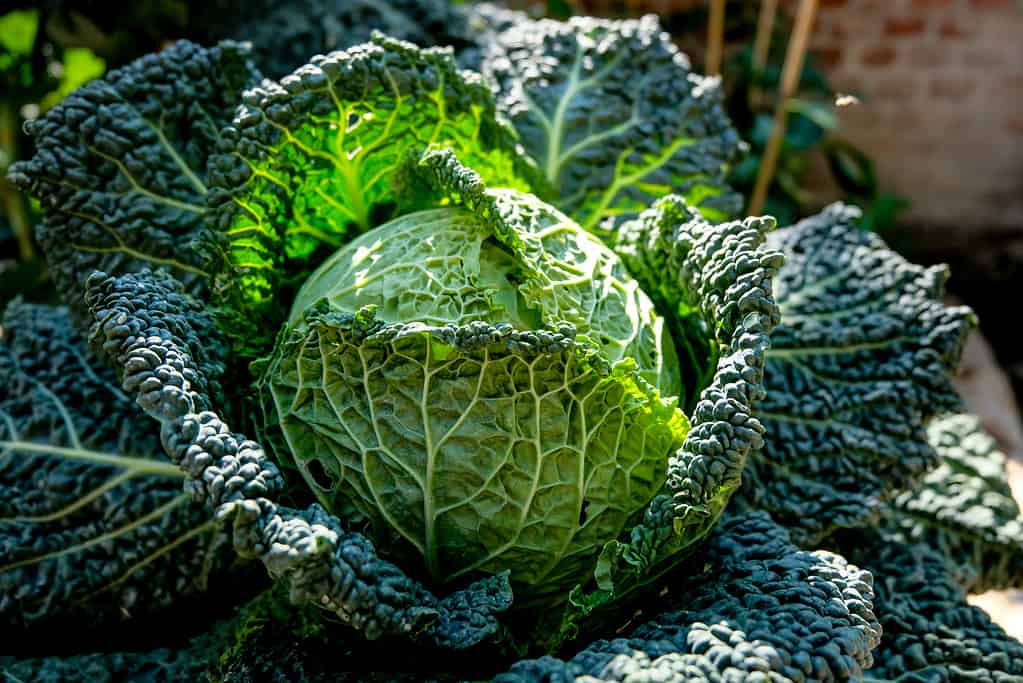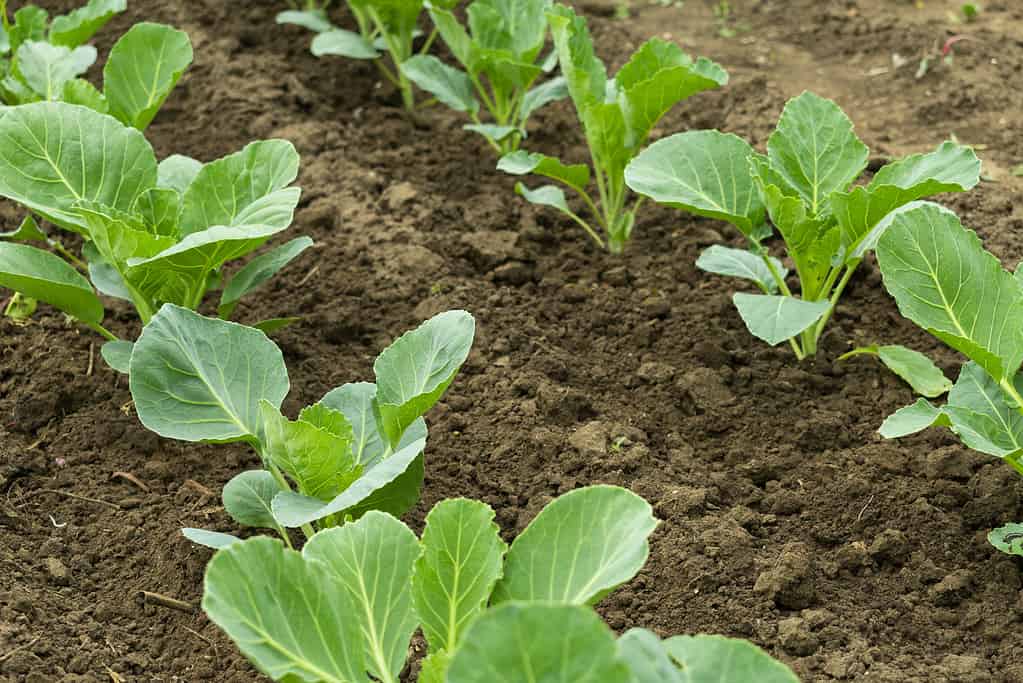Popular around the world for use in culinary dishes fresh, cooked, and pickled, cabbage is a well-loved food source and pretty easy to grow! If you’ve ever wanted to try your hand at growing your own veggies, cabbage is a great place to start! As long as you provide this cool-growing plant with its basic growing requirements, you’ll be rewarded with a bountiful crop!
In this guide, we’ll discuss the botanical classification of cabbage, its native range, its characteristics, and how to grow this cool-loving vegetable from seed and through transplanting.
So, without further ado, let’s get to it!
Cabbage: Botanical Classification, Native Range, and Characteristics
Domesticated cabbage is a descendant of wild cabbage (Brassica oleracea) and several varieties exist. The botanical name for cabbage depends on the variety but will always begin as Brassica oleracea var. (insert variety name such as capita for red and green cabbage or sabauda for savoy cabbage).
The original descendent of these domesticated varieties, wild cabbage, is native to the Eastern Mediterranean, and Southern and Western Europe. Over 2,000 years ago, farmers started the process of domesticating wild cabbage, resulting in domesticated varieties emerging. This process of domestication occurred in several regions throughout wild cabbage’s range, resulting in a high diversity of domesticated forms.
Today, domesticated cabbage takes a few different forms such as red cabbage, green cabbage, napa cabbage, and savoy cabbage. Red and green cabbage both form dense heads with tightly packed leaves. Savoy cabbage looks similar to green cabbage but with a looser head with much more ruffled leaves. Napa cabbage forms an elongated head with ruffled leaves and thick white veining.

Savoy cabbage looks similar to green cabbage but with a looser head and ruffled leaves.
©Vito Cangiulli/Shutterstock.com
How to Grow Cabbage
While different varieties exist, you can follow the same broad growing recommendations to ensure a healthy, productive crop. To help your plants thrive, it’s important to know the suitable growing zones, ideal soil and sunlight conditions, watering and fertilizer requirements, and how to plant these veggies from seed and how to transplant them.
Below, we’ll go in-depth on each of these topics.
Suitable USDA Growing Zones for Cabbage
Since cabbage can grow in both spring and fall, you can grow this plant in USDA Hardiness Zones 3-12. However, when you plant will depend heavily on your climate zone as cabbage, like many other brassicas, is a cool-growing vegetable. If you live in Zones 7-12, you likely need to focus on growing a fall crop as starting a crop in the spring in these warm Zones may result in your crop suffering from the heat of summer.
How to Grow Cabbage: Ideal Soil Conditions
Generally, most varieties of cabbage prefer to grow in fertile, well-draining, moist, and slightly acidic soil (6.0-6.8 pH). Some varieties, such as red cabbage, are more adaptable for growing in less-than-ideal soil types such as clay. Depending on the variety you’re growing, you may need to amend your soil with well-aged compost to improve soil structure and encourage a healthier soil microbial population.
For clay soils, this may involve tilling and incorporating compost and sand into the top 6 inches of soil, or you may focus on building healthy soil on top of the compacted ground. You can also incorporate gypsum (calcium sulfate) to increase aggregation. For sandy soils, incorporating compost into the soil is usually an easier and more successful endeavor, so you likely won’t need to build on top of this soil type.

Most cabbage varieties prefer to grow in fertile, well-draining, moist, and slightly acidic soil and thrive with 6 hours of full sun.
©iStock.com/Lusyaya
Ideal Sunlight Conditions
All cabbage varieties prefer to grow in at least 6 hours of full sun. This is especially true when you plant a spring crop. For a fall crop, if you live in an especially sunny area with warmer fall temperatures, it’s best to plant your cabbages in an area that receives full sunlight in the morning followed by light shade in the afternoon.
How to Grow Cabbage: Watering Requirements
Cabbage does best when watered deeply, but infrequently. This is in contrast to watering often but lightly. So, aim to provide 1-2 inches of water per week at a schedule of watering 2-3 times per week, rather than every day. In gardening terms, an inch of water refers to the gallons needed to cover a square foot garden area with one inch of water. So, in the gardening world, one inch of water comes out to about .5 gallons per square foot of bed space.
Since cabbage likes a lot of watering, you can mulch around the plants to help with moisture retention. Mulching or applying a leaf layer can also help prevent clay soils from pooling and baking into a hard surface in the summer months.
Fertilizer Requirements
Cabbage is a heavy feeder and likes consistent nutrient boosts while it’s growing. Many gardeners find success in applying a balanced 10-10-10 NPK (nitrogen-phosphorus-potassium) fertilizer or fish emulsion every 2-4 weeks until cabbage heads begin to form. At this point, refrain from applying more fertilizer as this can cause splitting or cracking of the heads. Also, make sure to avoid high-nitrogen fertilizers as this will cause the plant to focus more on foliage than head development.
How to Grow Cabbage: Direct Sowing Seeds into Your Garden Bed
Cabbage seeds can germinate in soil temperatures between 40-85 degrees Fahrenheit, but the ideal temperature range is 70-75 degrees Fahrenheit. At this temperature, expect germination in 4-7 days (depending on variety).
For growers who live in Zones 2-6, you should have success direct sowing cabbage seeds for a spring crop. Aim to direct sow 2-3 weeks after the last expected frost. For a fall crop, plant about 4-6 weeks before the last expected frost for your area.
Ideally, sow seeds into moist, workable soil 1/2 inch deep and 3 inches apart. Once the seedlings are 4-6 inches high, you can thin them to 18 inches apart. Time to harvest will depend on the cultivar of cabbage that you’re growing, as some cabbages are considered early-season, mid-season, or late-season varieties.
Early-season cabbages are fast-growing, produce smaller heads, and mature early. Some early-season cultivars are ‘Parel’ and ‘Savoy Express’. These are ready for harvest within 50-55 days.
Mid-season cultivars often produce larger, dense heads and can be planted in the spring but must be well-established before the summer heat sets in. If you live in a warmer area, mid-season cultivars will need to be started indoors before the last frost and transplanted outside. These include cultivars such as ‘Primero’ and ‘Ruby Ball’, which are ready between 72-78 days.
Late-season cabbages are not typically grown in the spring, but instead, are grown for harvesting in the fall and winter (depending on your climate zone). They are typically ready for harvest in 90-125 days and are a good candidate for storing in root cellars over the winter. Cultivars include ‘Kaitlin’ and ‘Danish Ballhead’.

When growing a spring crop of cabbage in Zones 7-12, it’s best to start your seeds indoors in late winter and then transplant outdoors in spring.
©iStock.com/axeiz77
How to Transplant Cabbage Seedlings into Your Garden Bed
If you want to grow a spring crop but live in Zones 7-12, it’s best to start your seeds indoors in late winter or buy young plants to prevent these cool-loving plants from maturing in the heat of the summer.
If your seedlings haven’t been exposed to outdoor conditions, you’ll need to acclimate them first before transplanting them. This significantly reduces the chances that your plants suffer from transplant shock. Once your seedlings have 4-5 mature leaves on them, you can harden them off to outdoor conditions with gradual exposure over a week. Start out by placing them in a shady location for a couple of hours on a mild, non-windy day with daytime temperatures above 50 degrees Fahrenheit. The next day, set them in the shade for 2 hours followed by sun exposure for 2 hours. Gradually increase this sun exposure until they can sit in full sun for at least 6 hours. If your area is still getting below 45 degrees at night, you’ll want to also gradually expose them to nighttime temps until they can sit out all night.
Choose a mild, overcast, non-windy day for transplanting. You can also transplant in the evening when the sun intensity is greatly decreased. This will also decrease the risk of transplant shock. Dig your holes about an inch deeper than the plant’s container depth and space your cabbages out by 18 inches. Rows should be spaced about 30-36 inches apart. Make sure to premoisten the soil to set your plants up for success. Water lightly every day for the first week to help them establish, and then cut back to infrequent, thorough watering as discussed in the watering section.
The photo featured at the top of this post is © iStock.com/lzf
Thank you for reading! Have some feedback for us? Contact the AZ Animals editorial team.






